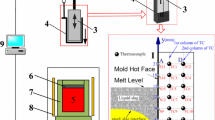Abstract
An integrated understanding of heat transfer during solidification, friction/lubrication at solid-liquid interface, high temperature properties of the solidifying shell etc. is necessary to control the continuous casting process. The present paper elaborates upon the knowledge developed in the areas of initial shell formation, mode of mould oscillation, and lubrication mechanism. The effect of these issues on the caster productivity and the quality of the product has been discussed. The influence of steel chemistry on solidification dynamics, particularly with respect to mode of solidification and its consequence on strength and ductility of the solidifying shell, has been dealt with in detail. The application of these basic principles for casting of stainless steel slabs and processing to obtain good quality products have been covered.
Similar content being viewed by others

References
Andrezejewski P, Drastik A, Kohler K U, Pluschkell W 1990 New aspects of oscillation mode operation and results in slab casting.Process Tech. Conference Proc. (Warrendale, PA: Iron & Steel Soc.) vol. 9, pp 173–181
Brendzy J L, Bakshi I A, Samarasekara I V, Brimacombe J K 1993 Mould-strand interaction in continuous casting of steel billets, part 2: Lubrication and oscillation mark formation.Ironmaking Steelmaking 20: 63–69
Brimacombe J K 1993 Intelligent mould for continuous casting of billets.Metall. Trans. B24: 917–928
Darle T, Mouchette A, Nadif M, Roscini M, Salvadori D 1993 Hydraulic oscillation of the CC slab mould at Soleac Florange: First industrial results, future development.Steelmaking Conference Proc. (Warrendale, PA: Iron & Steel Soc.) vol. 76, pp. 209–218
Harada S, Tanaka S, Misumi H 1990 A formation mechanism of transverse cracks on CC slab surface quality. South East Asian Iron & Steel Institute, pp 26–32
Hoedle H, Frauenhuber K, Moerwald K 1999 Advanced equipment for high performance casters.Steelmaking Conference Proc, vol. 82, pp. 141–151
Kim K, Yeo T, Oh K B, Lee D N 1996 Effect of carbon & sulphur on longitudinal surface cracks.Iron Steel Inst. Jpn. Int. 36: 284–292
Nakagawa T, Umeda T, Murate T 1995 Strength and ductility of solidifying shell during casting.Trans. Iron Steel Inst. Jap. 35: 723–728
Ray S K 2001 Effect of chemistry and solidification behaviour on quality of cast slabs and rolled products of stainless steel.J. Mater. Performance (accepted)
Ray S K, Mukhopadhyay B, Bhattacharyya S K 1996 Prediction of crack-sensitivity of concast slabs of AISI-430 stainless steel.Iron Steel Inst. Jpn. Int. 36: 611–612
Ray S K, Mukhopadhyay B, Das P C 1999 Effect of chemistry on solidification and quality of stainless steel. Presented at Annu. Tech. Mtg. of Indian Inst. Metals, Jamshedpur, 14–17 Nov. 1999
Saucedo I G 1991 Early solidification during continuous casting of steel.Steelmaking Conference. Proc. (Warrendale, PA: Iron & Steel Soc.) vol. 74, pp 79–89
Sen S, Mukhopadhyay B, Ray S K 1996 Continuous casting and hot rolling of AISI-310 stainless.Steel India 19: 18–23
Suzuki M, Mizukmi H, Kitagawa T, Kawakami K, Uchida S, Komatsu Y, 1991 Development of new mould oscillation mode for high-speed casting.Iron Steel Inst. Jpn. Int. 31: 254–261
Szekeres E S 1996 Overview of mould oscillation in continuous casting.Iron Steel Eng. July: 29–37
Tada K, Birat J P, Riboud P, Larrecq M, Hackel H 1984 Modelling of slag rim formation and pressure in molten flux near the meniscus.Trans Iron Steel Inst. Jpn. 24: B-382–B-387
Takeuchi E, Brimacombe J K 1984 The formation of oscillation marks in the continuous casting of steel slabs.Metall. Trans. B15: 493–509
Takeuchi S, Miki Y, Itoyama S, Kobayishi K, Sorimachi K, Sakuraya T 1991 Control of oscillation mark formation during continuous casting.Steelmaking Conference Proc. (Warrendale, PA: Iron & Steel Soc.) vol. 74, p. 303
Wolf M M 1986 Strand surface quality of stainless steel.Ironmaking Steelmaking 13: 248–259
Wolf M M 1991a Mould oscillation guidelines.Steelmaking Conference Proc. (Warrendale, PA: Iron & Steel Soc.) vol. 74, pp 51–67
Wolf MM 1991b Crack susceptibility of new grades of steel.Proc. Ist European Conf. on Continuous Casting, Florence, pp 2.489–2.498
Wolf M M, Kurz W 1981 Effect of carbon on solidification of steel in concast moulds.Metall. Trans. B12: 85–93
Author information
Authors and Affiliations
Corresponding author
Rights and permissions
About this article
Cite this article
Mazumdar, S., Ray, S.K. Solidification control in continuous casting of steel. Sadhana 26, 179–198 (2001). https://doi.org/10.1007/BF02728485
Issue Date:
DOI: https://doi.org/10.1007/BF02728485



